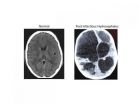(Press-News.org) UNIVERSITY PARK, Pa. -- The amount of rainfall affects the number of infant infections leading to hydrocephalus in Uganda, according to a team of researchers who are the first to demonstrate that these brain infections are linked to climate.
Hydrocephalus -- literally "water on the brain" -- is characterized by the build-up of the fluid that is normally within and surrounding the brain, leading to brain swelling. The swelling will cause brain damage or death if not treated. Even if treated, there is only a one-third chance of a child maintaining a normal life after post-infectious hydrocephalus develops, and that chance is dependent on whether the child has received the best treatment possible.
"The most common need for a child to require neurosurgery around the world is hydrocephalus," said Steven J. Schiff, the Brush Chair Professor of Engineering, director of the Penn State Center for Neural Engineering and a team member.
In sub-Saharan Africa, upward of 100,000 cases of post-infectious hydrocephalus a year are estimated to occur. The majority of these cases occur after a newborn has suffered from neonatal sepsis, a blood infection that occurs within the first four weeks of life, the researchers reported in a recent issue of the Journal of Neurosurgery: Pediatrics.
Benjamin C. Warf, associate professor of neurosurgery, Harvard Medical School, Boston Children's Hospital, noticed that about three or four months after an infant in East Africa had an infection like neonatal sepsis, the child would often return to the clinic with a rapidly growing head -- hydrocephalus. Schiff joined Warf to help figure out what caused this disease so frequently.
Schiff and colleagues tracked 696 hydrocephalus cases in Ugandan infants between the years 2000 and 2005. The researchers obtained localized rainfall data for the same time frame through NOAA (National Oceanic and Atmospheric Administration) weather satellites using the African Rainfall Estimation Algorithm developed at the U.S. NOAA Climate Prediction Center.
Uganda has two peak rainfall seasons, in spring and fall. By comparing the data from NOAA and the hydrocephalus cases, the researchers found that instances of the disorder rose significantly at four different times throughout the year -- before and after the peak of each rainy season, when the amount of rainfall was at intermediate levels. In Uganda an intermediate rainfall is about 6 inches of rain per month.
Schiff and colleagues previously noted that different bacteria appear associated with post-infectious hydrocephalus at different seasons of the year. While the researchers have not yet characterized the full spectrum of bacteria causing hydrocephalus in so many infants, they note that environmental conditions affect conditions supporting bacterial growth, and that the amount of rain can quench bacterial infections. The moisture level clearly affects the number of cases of hydrocephalus in this region of East Africa.
"Hydrocephalus is the first major neurosurgical condition linked to climate," said Schiff, who is also professor of neurosurgery, engineering science and mechanics, and physics, and a faculty member of the Huck Institutes of the Life Sciences. "This means that a substantial component of these cases are almost certainly driven from the environmental conditions, and that means they are potentially preventable if we understand the routes and mechanisms of infection better."
INFORMATION:
Other members of the research team were Sylvia L. Ranjeva, who was then a Penn State Schreyer Honors College undergraduate and now at the University of Chicago Medical School, and Timothy D. Sauer, professor of mathematics, George Mason University.
The Penn State Clinical and Translational Sciences Institute; the Pennsylvania Department of Health, Commonwealth Universal Research Enhancement (CURE) Program; and the Harvey F. Brush Endowment funds supported this work.
**vmi**
Rainfall, brain infection linked in sub-Saharan Africa
2013-01-04
ELSE PRESS RELEASES FROM THIS DATE:
Researchers seek longer battery life for electric locomotive
2013-01-04
UNIVERSITY PARK, Pa. -- Norfolk Southern Railway No. 999 is the first all-electric, battery-powered locomotive in the United States. But when one of the thousand lead-acid batteries that power it dies, the locomotive shuts down. To combat this problem, a team of Penn State researchers is developing more cost-effective ways to prolong battery life.
The experimental locomotive's batteries, just like automotive batteries, are rechargeable until they eventually die. A leading cause of damage and death in lead-acid batteries is sulfation, a degradation of the battery caused ...
Outsourced radiologists perform better reading for fewer hospitals
2013-01-04
UNIVERSITY PARK, Pa. -- Experience working for a particular hospital matters when it comes to the performance of radiologists who work for outsourcing teleradiology companies, according to a team of researchers, whose finding could have important implications, given the growing use of telemedicine.
"More than half of all hospitals now use teleradiology services," said Jonathan Clark, assistant professor of health policy and administration, Penn State. "Hospitals send their X-rays, CT scans, MRIs and other images to outsourcing companies who then forward the images to ...
Scripps physicians call for change in cancer tissue handling
2013-01-04
SAN DIEGO – Genetic sequencing technology is altering the way cancer is diagnosed and treated, but traditional specimen handling methods threaten to slow that progress.
That's the message delivered this week in a column appearing in the Journal of the American Medical Association (JAMA) by Scripps Clinic physicians Eric Topol, Kelly Bethel and Laura Goetz.
Dr. Topol is a cardiologist who serves as chief academic officer of Scripps Health and director of the Scripps Translational Science Institute (STSI), leading Scripps' genomic medicine research efforts. Dr. Bethel ...
Research update: Jumping droplets help heat transfer
2013-01-04
CAMBRIDGE, MA -- Many industrial plants depend on water vapor condensing on metal plates: In power plants, the resulting water is then returned to a boiler to be vaporized again; in desalination plants, it yields a supply of clean water. The efficiency of such plants depends crucially on how easily droplets of water can form on these metal plates, or condensers, and how easily they fall away, leaving room for more droplets to form.
The key to improving the efficiency of such plants is to increase the condensers' heat-transfer coefficient — a measure of how readily heat ...
Your brain on Big Bird
2013-01-04
Using brain scans of children and adults watching Sesame Street, cognitive scientists are learning how children's brains change as they develop intellectual abilities like reading and math.
The novel use of brain imaging during everyday activities like watching TV, say the scientists, opens the door to studying other thought processes in naturalistic settings and may one day help to diagnose and treat learning disabilities.
Scientists are just beginning to use brain imaging to understand how humans process thought during real-life experiences. For example, researchers ...
Study reveals new survival strategy for bacteria exposed to antibiotics
2013-01-04
Researchers have uncovered a new way that some bacteria survive when under siege by antibiotics.
This survival mechanism is fundamentally different from other, known bacterial strategies. Understanding it may be useful for designing drugs that target hard-to-treat bacterial strains, such as drug-resistant tuberculosis, an increasingly urgent public health problem. The study is based on Mycobacterium smegmatis, a cousin of the microbe that causes TB, and its response to the TB drug isoniazid.
The research, by Yuichi Wakamoto of the University of Tokyo and Neeraj Dhar ...
Steroids that only nature could make on a large scale -- Until now
2013-01-04
LA JOLLA, CA – January 3, 2013 – Scientists at The Scripps Research Institute (TSRI) have achieved a feat in synthetic chemistry by inventing a scalable method to make complex natural compounds known as "polyhydroxylated steroids." These compounds, used in heart-failure medications and other drugs, have been notoriously problematic to synthesize in the laboratory.
The researchers demonstrated the new strategy by synthesizing ouabagenin [wa-bah-jenn-in], a close chemical cousin of ouabain, which Somali tribes once used as a potent poison on the tips of their arrows but ...
Coral records suggest that recent El Nino activity rises above noisy background
2013-01-04
VIDEO:
By studying a set of fossil corals that are as much as 7,000 years old, scientists have dramatically expanded the amount of information available on the El Nino-Southern Oscillation, a...
Click here for more information.
By examining a set of fossil corals that are as much as 7,000 years old, scientists have dramatically expanded the amount of information available on the El Nino-Southern Oscillation, a Pacific Ocean climate cycle that affects climate worldwide. The ...
Rethinking bacterial persistence
2013-01-04
It's often difficult to completely eliminate a bacterial infection with antibiotics; part of the population usually manages to survive. We've known about this phenomenon for quite some time, dating back nearly to the discovery of penicillin. For more than 50 years, scientists have believed that the resistant bacteria were individuals that had stopped growing and dividing.
Up to now, in fact, it hasn't been possible to track the growth of cells before and after their exposure to antibiotics, which makes any analysis of the phenomenon quite imprecise. "Using microfluidics, ...
First meteorite linked to Martian crust
2013-01-04
Washington, D.C.—After extensive analyses by a team of scientists led by Carl Agee at the University of New Mexico, researchers have identified a new class of Martian meteorite that likely originated from the Mars's crust. It is also the only meteoritic sample dated to 2.1 billion years ago, the early era of the most recent geologic epoch on Mars, an epoch called the Amazonian. The meteorite was found to contain an order of magnitude more water than any other Martian meteorite. Researchers from the Carnegie Institution (Andrew Steele, Marilyn Fogel, Roxane Bowden, and Mihaela ...




